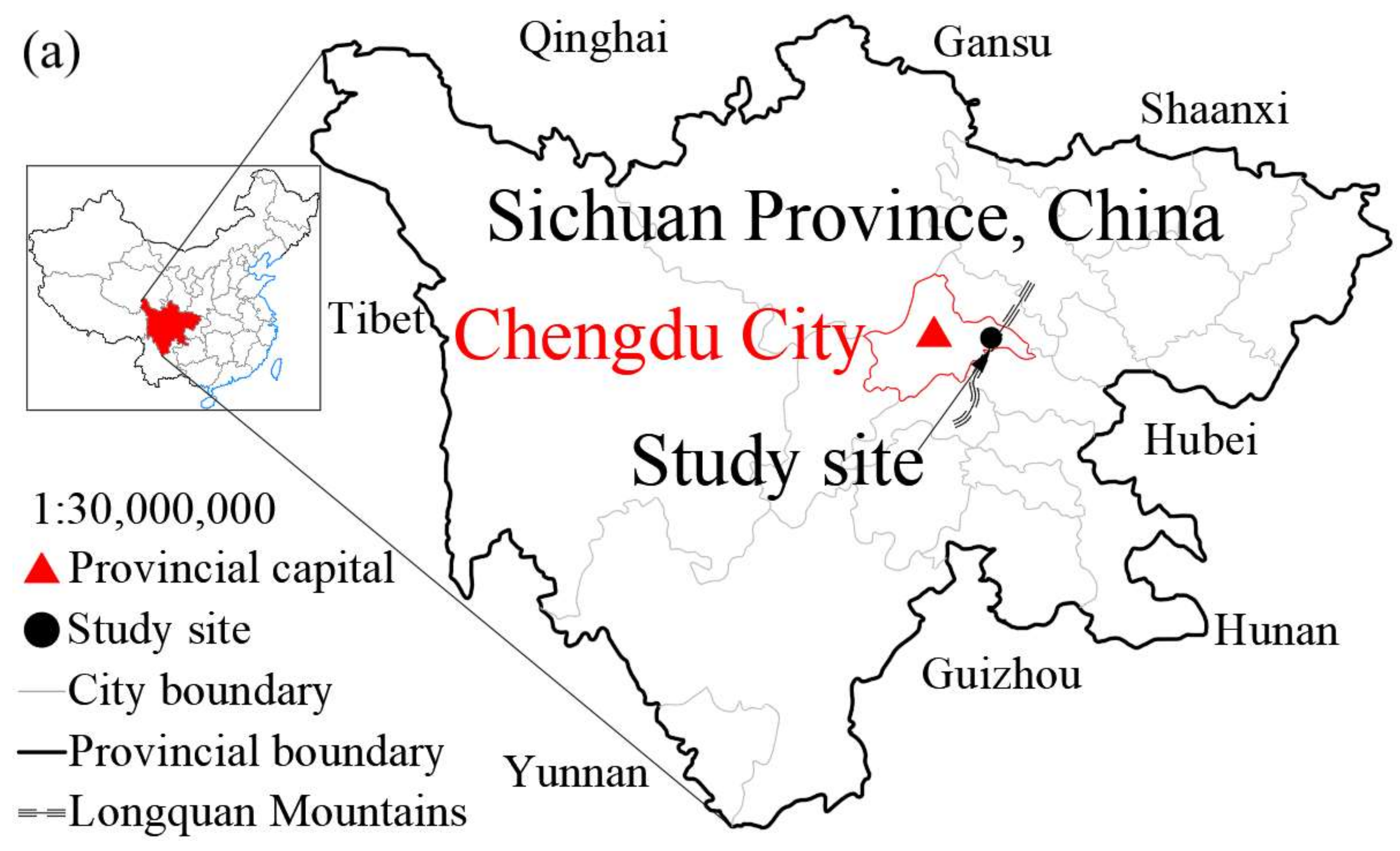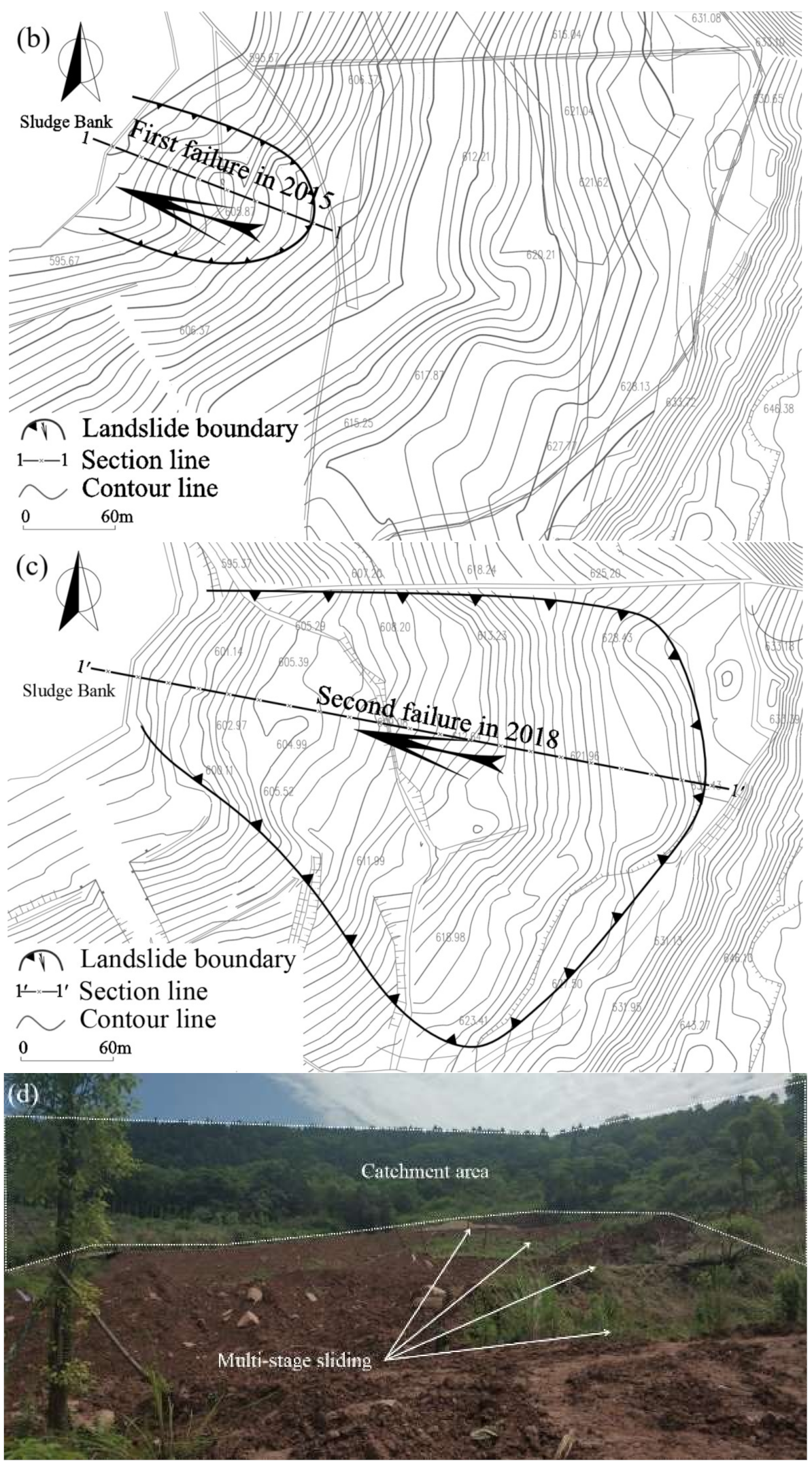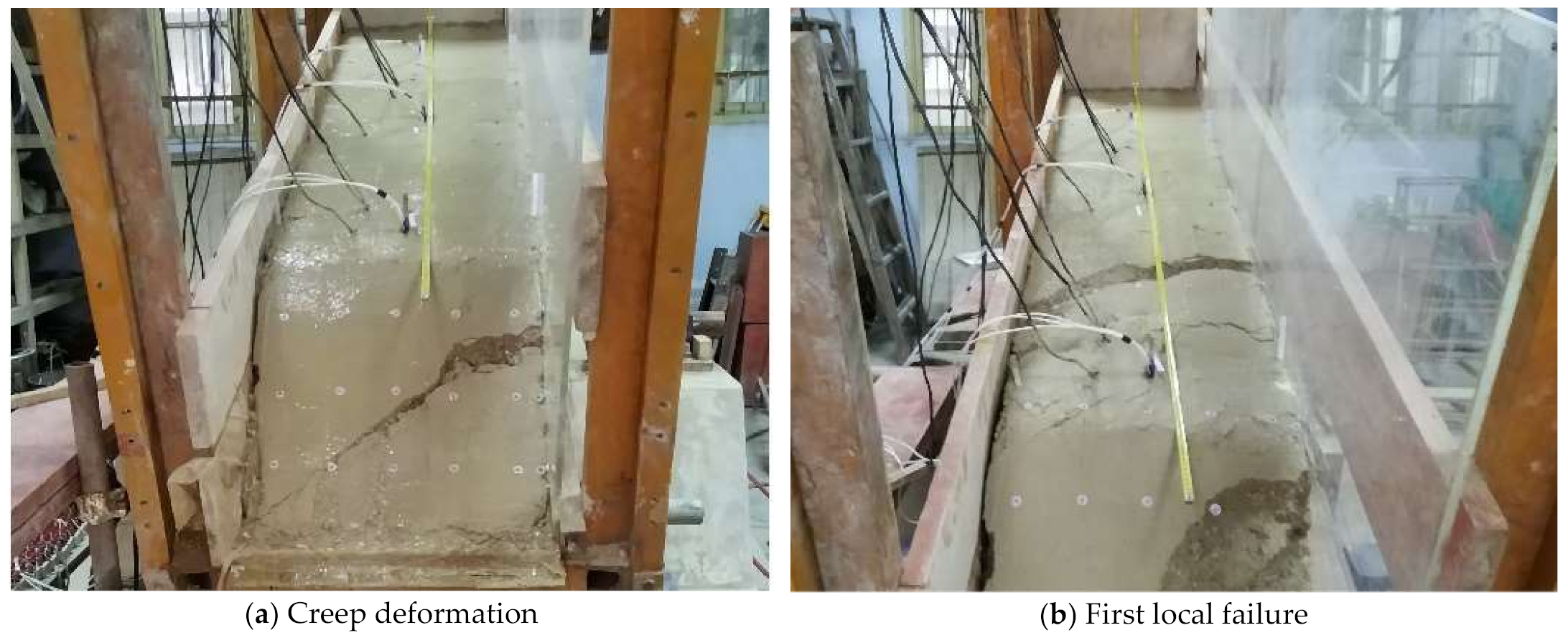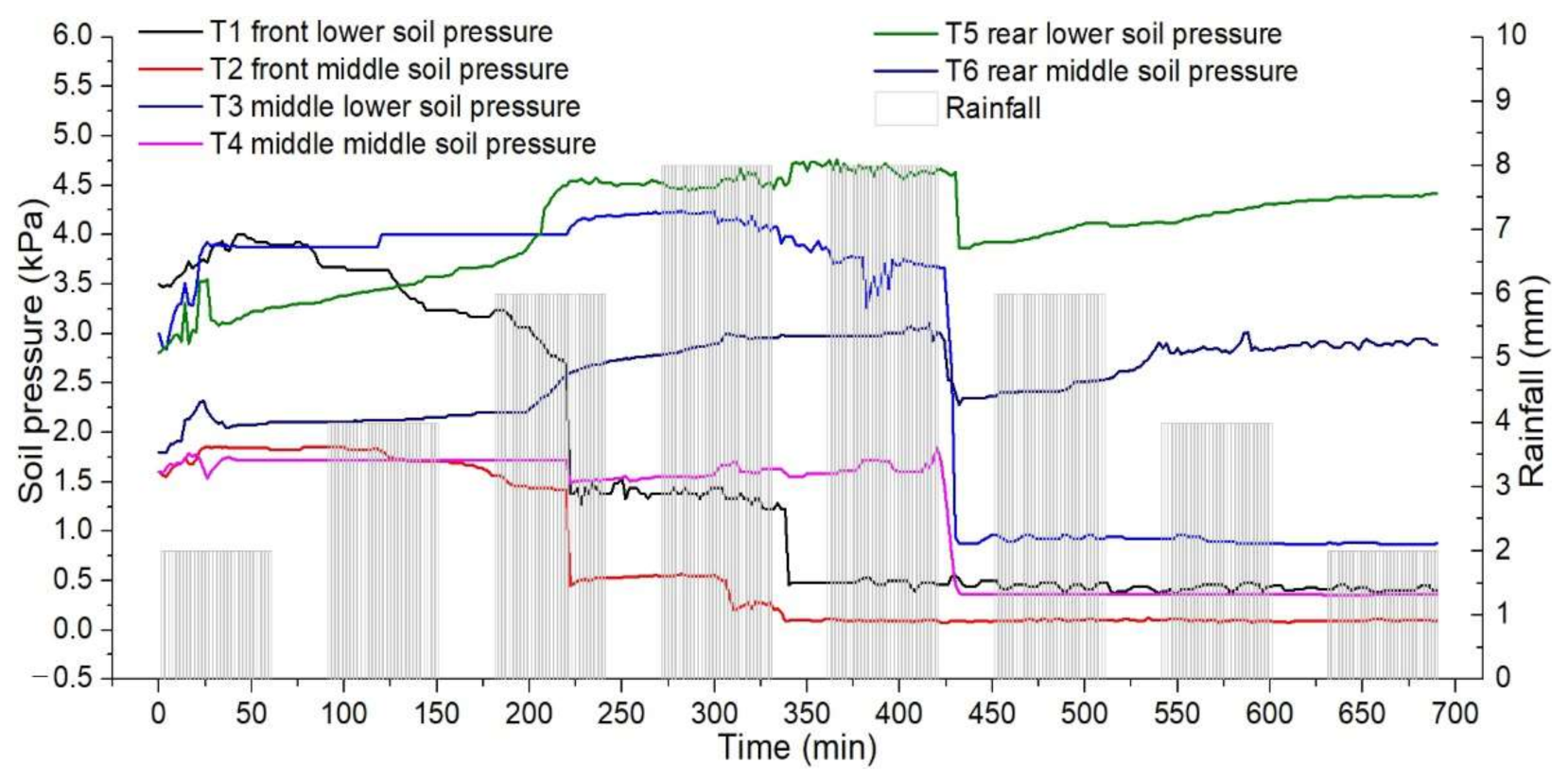Physical Model Study of an Intermittent Rainfall-Induced Gently Dipping Accumulation Landslide
Abstract
:1. Introduction
2. Case History
3. Experimental Methodology
3.1. Model Facility and Materials
3.2. Model Similarity
3.3. Instrumentation
3.4. Intermittent Rainfall Modelling
4. Test Results
4.1. Deformation and Failurecharacteristic
4.2. Response of Pore Water Pressure
4.3. Earth Pressure
5. Discussion
6. Conclusions
- (1)
- Intermittent rainfall-induced failures of gently dipping accumulation slopes are characterised by regressive landslides. Firstly, transverse tension cracks are formed on the slope, and the first local failure is caused at the toe of the slope. Following this, the second local failure is triggered at the front of the slope. The third local failure is triggered in the middle of the slope. Finally, the main cracks spread, forming multiple sliding steps and sliding surfaces on the slope. The use of anti-slide piles at the slope foot of the gently sloping accumulation layer can effectively restrain the occurrence of landslides.
- (2)
- Before failure, a gently dipping accumulation layer landslide shows long-term creep deformation, when the clay particles in the soil would converge to the cracks, sliding zone and slope toe with seepage. The increasing creep displacement and increasing saturation thickness from the trailing edge to the leading edge of the slope provide a precondition for the cracking and stage failure of the landslide. Monitoring the displacement, pore water pressure and earth pressure at the foot of the slope may be effective for forecasting and the early warning of this type of landslide.
- (3)
- Shear strength testing of the undisturbed soil showed that when the water table approached the slope surface within this region, the reduced shear strength due to the increase in moisture content was still sufficient to resist local failure. The shear strength of the soil in the saturated zone further decreased with an increase in the clay content, saturated time, creep displacement and creep rate. This eventually led to a sudden increase in pore water pressure and liquefaction of the soil, triggering local failure. In the actual project, slope drainage and waterproofing measures should be taken to prevent the soil at the foot of the slope from being saturated for a long time.
Author Contributions
Funding
Institutional Review Board Statement
Informed Consent Statement
Data Availability Statement
Acknowledgments
Conflicts of Interest
References
- Zhu, Y.J.; He, N.; Zhong, W.; Kong, J.M. Physical Simulation Study on Accumulation Layer Slope Deformation and Damage Caused by Intermittent Rainfall. Rock Soil Mech. 2020, 41, 1–10. [Google Scholar] [CrossRef]
- Li, H.; Li, C.B.; Liu, Y.B.; Han, J.; Zhao, Q.H.; Coltd, C.E.; China, P. Geostress field characteristics of high steep canyon slope in Southwest China. Rock Soil Mech. 2016, 37, 482–488. [Google Scholar] [CrossRef]
- Xing, Z.; Ma, S.Q.; Xu, Q.; Liu, W. A WD-GA-LSSVM model for rainfall-triggered landslide displacement prediction. J. Mt. Sci. 2018, 15, 156–166. [Google Scholar] [CrossRef]
- Zhang, M.; Hu, R.L.; Yin, Y.P.; Wu, R. Study of mechanism of landslide induced by rainfall in gently inclined red stratum in east Sichuan basin. Chin. J. Rock Mech. Eng. 2014, 33, 3783–3790. [Google Scholar] [CrossRef]
- Zhang, Q.; Xu, Q.; Li, J.; Yi, J.S.; Wang, F. Study on characteristics and cause mechanism of grouping inclined—Shallow soil mass landslides on September 16, 2011 in Nanjiang. J. Nat. Disasters 2015, 24, 104–111. [Google Scholar] [CrossRef]
- Do, F.; Xu, M.; Xiao, X.Y.; Na, N. Physical simulation modeling for stability analysis of reser-voir landslide in gently underdip slopes: A case study of Xiangjiaping landslide. J. Eng. Geol. 2018, 26, 694–702. [Google Scholar] [CrossRef]
- Roy, P.; Jain, N.; Martha, T.R.; Kumar, K.V. Reactivating Balia Nala landslide, Nainital, India—A disaster in waiting. Landslides 2022, 19, 1531–1535. [Google Scholar] [CrossRef]
- Ran, Q.; Hong, Y.; Li, W.; Gao, J. A modelling study of rainfall-induced shallow landslide mechanisms under different rainfall characteristics. J. Hydrol. 2018, 563, 790–801. [Google Scholar] [CrossRef]
- Ram, K.R.; Kwansue, J.; Hajime, N.; Jaewon, K. Study on mechanism of retrogressive slope failure using artificial rainfall. Catena 2014, 122, 27–41. [Google Scholar] [CrossRef]
- Guo, M.; Su, A.G.; Zhang, J. Deformation Characteristics and Formation Mechanism of Ac-cumulated Landslides Under Rainfall Conditions. J. Hebei Univ. Eng. (Nat. Sci. Ed.) 2019, 36, 39–45. [Google Scholar]
- Cho, E.S. Probabilistic stability analysis of rainfall-induced landslides considering spatial variability of permeability. Eng. Geol. 2014, 171, 11–20. [Google Scholar] [CrossRef]
- Scaringi, G.; Hu, W.; Xu, Q.; Huang, R. Shear-Rate-Dependent Behavior of Clayey Bimaterial Interfaces at Landslide Stress Levels. Geophys. Res. Lett. 2017, 45, 766–777. [Google Scholar] [CrossRef] [Green Version]
- Crosta, G.; Di Prisco, C. On slope instability induced by seepage erosion. Can. Geotech. J. 1999, 36, 1056–1073. [Google Scholar] [CrossRef]
- Gattinoni, P.; Francani, V. A tool for modeling slope instability triggered by piping. World Acad. Sci. Eng. Technol. 2009, 3, 238–244. [Google Scholar]
- Song, D.; Chen, X.; Zhou, G.G.; Lu, X.; Cheng, G.; Chen, Q. Impact dynamics of debris flow against rigid obstacle in laboratory experiments. Eng. Geol. 2021, 291, 106211. [Google Scholar] [CrossRef]
- Lourenço., S.D.N.; Sassa, K.; Fukuoka, H. Failure process and hydrologic response of a two layer physical model: Implications for rainfall-induced landslides. Geomorphology 2006, 73, 115–130. [Google Scholar] [CrossRef]
- Tohari, A.; Nishigaki, M.; Komatsu, M. Laboratory Rainfall-Induced Slope Failure with Moisture Content Measurement. J. Geotech. Geoenviron. Eng. 2007, 133, 575–587. [Google Scholar] [CrossRef]
- Pajalić, S.; Peranić, J.; Maksimović, S.; Čeh, N.; Jagodnik, V.; Arbanas, Z. Monitoring and Data Analysis in Small-Scale Landslide Physical Model. Appl. Sci. 2021, 11, 5040. [Google Scholar] [CrossRef]
- Lora, M.; Camporese, M.; Troch, P.A.; Salandin, P. Rainfall-triggered shallow landslides: Infiltration dynamics in a physical hillslope model. Hydrol. Process. 2016, 30, 3239–3251. [Google Scholar] [CrossRef]
- Rolando, P.O.; Suguru, S.; Kengo, M.; Ikuo, T. Instrumented Model Slope Failure due to Water Seepage. J. Nat. Disaster Sci. 2006, 26, 15–26. [Google Scholar] [CrossRef] [Green Version]
- Shen, H.H. Stability analysis and treatment for the Zhongjiashan landslide in Long-quanyi, Chengdu. J. Geol. Hazards Environ. Preserv. 2005, 16, 311–314, (In Chinese with English Abstract). [Google Scholar]
- Xu, T. The Similarity Theory and the Statics Model Test; China Agricultural Mechanical Press: Beijing, Chnina, 1982; (In Chinese Book). [Google Scholar]
- Chen, S.X.; Xu, X.C.; Xu, H.B. Features and stability analysis of rainfall-induced colluvial landslides. Rock Soil Mech. 2005, 26, 6–10. [Google Scholar] [CrossRef]
- Pu, J.; Wallwork, J.; Khan, A.; Pandey, M.; Pourshahbaz, H.; Satyanaga, A.; Hanmaiahgari, P.; Gough, T. Flood Suspended Sediment Transport: Combined Modelling from Dilute to Hyper-Concentrated Flow. Water 2021, 13, 379. [Google Scholar] [CrossRef]
- John, C.; Pu, J.; Pandey, M.; Hanmaiahgari, P. Sediment Deposition within Rainwater: Case Study Comparison of Four Different Sites in Ikorodu, Nigeria. Fluids 2021, 6, 124. [Google Scholar] [CrossRef]
- Lei, J.; Zhang, G.M.; Liu, L.F.; Yang, Y.; Zhiqiang, Q.U.; Wen, H.; Dai, J. Measuring soil shear strength and impact factors. J. Beijing Norm. Univ. (Nat. Sci.) 2016, 52, 486–492. [Google Scholar] [CrossRef]
- Xu, C.X.; Wang, X.; Du, X.L. Experimental study on residual strength and index of shear strength characteristics of different clay soils. Chin. J. Geotech. Eng. 2017, 39, 436–443. [Google Scholar] [CrossRef]
- Xie, Q.; Zhang, G.D.; Hu, X.W.; Lu, J. Experimental researches on residual strength of satu-rated silty clay at different shear rates. J. China Three Gorges Univ. (Nat. Sci.) 2019, 41, 52–55. [Google Scholar] [CrossRef]


















| Property | Real Soil | Test Soil |
|---|---|---|
| Density | 1.95 | 1.95 |
| Cohesion | 13.0 | 0.63 |
| Internal friction angle | 12.0 | 10.8 |
| Poisson’s ratio | 0.26 | 0.28 |
| Elastic modulus | 31058 | 2099 |
Publisher’s Note: MDPI stays neutral with regard to jurisdictional claims in published maps and institutional affiliations. |
© 2022 by the authors. Licensee MDPI, Basel, Switzerland. This article is an open access article distributed under the terms and conditions of the Creative Commons Attribution (CC BY) license (https://creativecommons.org/licenses/by/4.0/).
Share and Cite
Zhong, W.; Zhu, Y.; He, N. Physical Model Study of an Intermittent Rainfall-Induced Gently Dipping Accumulation Landslide. Water 2022, 14, 1770. https://doi.org/10.3390/w14111770
Zhong W, Zhu Y, He N. Physical Model Study of an Intermittent Rainfall-Induced Gently Dipping Accumulation Landslide. Water. 2022; 14(11):1770. https://doi.org/10.3390/w14111770
Chicago/Turabian StyleZhong, Wei, Yuanjia Zhu, and Na He. 2022. "Physical Model Study of an Intermittent Rainfall-Induced Gently Dipping Accumulation Landslide" Water 14, no. 11: 1770. https://doi.org/10.3390/w14111770
APA StyleZhong, W., Zhu, Y., & He, N. (2022). Physical Model Study of an Intermittent Rainfall-Induced Gently Dipping Accumulation Landslide. Water, 14(11), 1770. https://doi.org/10.3390/w14111770






